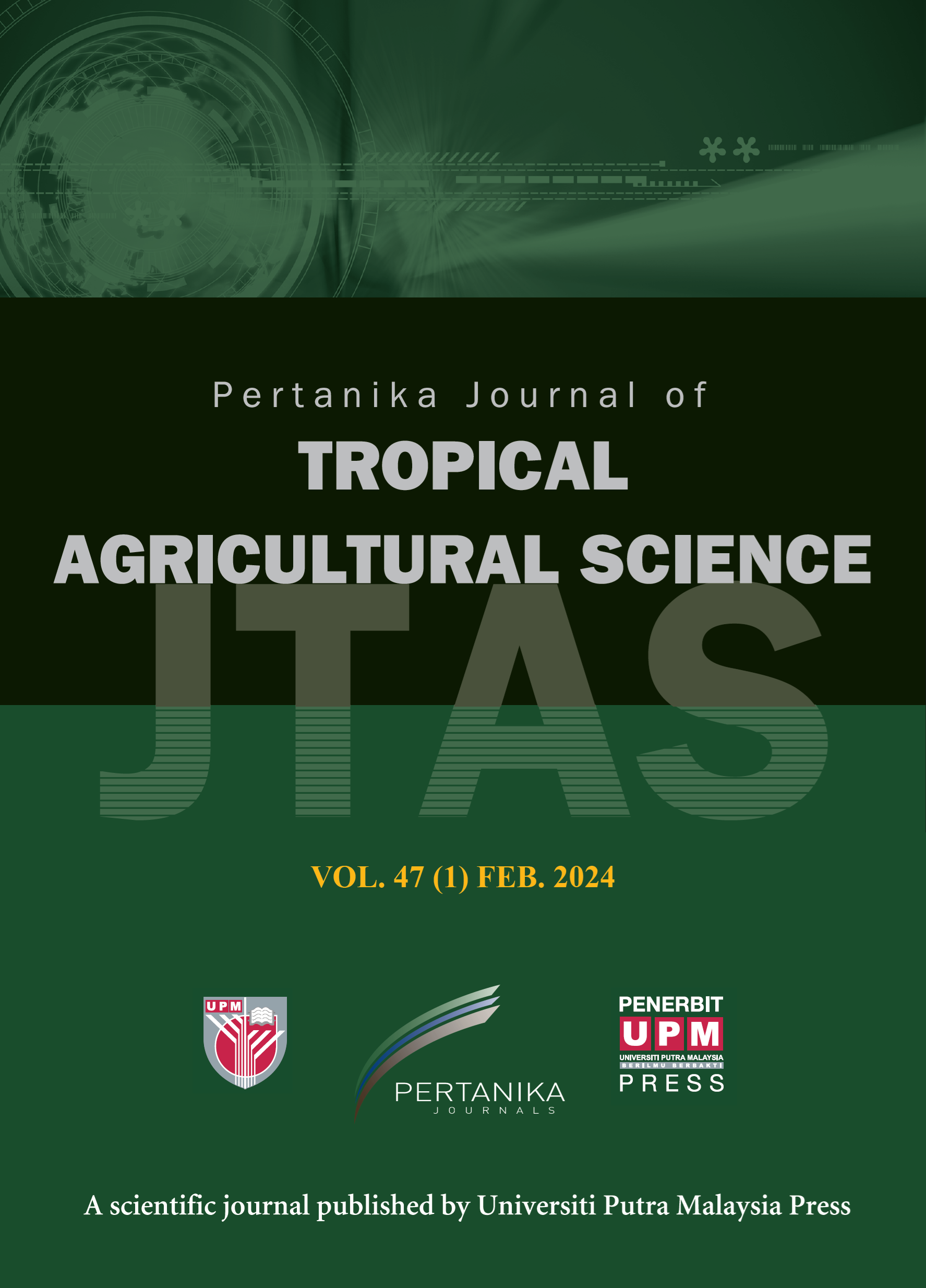PERTANIKA JOURNAL OF TROPICAL AGRICULTURAL SCIENCE
e-ISSN 2231-8542
ISSN 1511-3701
Germination Behavior of Deteriorated Shallot Seeds Applied with Zinc as Priming Agent
Abdul Jalil, Elkawakib Syam’un and Syatrianty Andi Syaiful
Pertanika Journal of Tropical Agricultural Science, Pre-Press
DOI: https://doi.org/10.47836/pjtas.48.2.02
Keywords: Path analysis, principal component analysis, seed priming, shallots, variety
Published: 2025-02-17
This study aims to see the effect of applying the seed priming method with the provision of micronutrient zinc (Zn) on the germination performance of two types of shallot varieties from deteriorated botanical seeds. The study was arranged on a completely randomized design with two factors. The first factor was the type of variety consisting of two combinations: Lokananta and Maserati. The second factor is priming, composed of unprimed, hydropriming indole 3 acetic acid (IAA), zinc oxide (ZnO), zinc sulfate heptahydrate (ZnSO4.7H2O), zinc ethylenediaminetetraacetic acid (Zn-EDTA). The combination of the Maserati variety and Zn-EDTA priming recorded the fastest mean germination time (2.82 days), the highest germination rate index (16.15%/day), and the coefficient velocity of germination (35.51) compared to other treatment combinations. The combination of the Maserati variety and ZnSO4.7H2O priming recorded the highest germination percentage (86%) compared to different treatment combinations. Then, the combination of Lokananta and ZnO priming recorded the most increased vigor index (453.20), produced the most extended plumule length (55.30 mm), longest radicle length (11.00 mm), fresh weight (19.00 mg), and dry weight (2.34 mg) compared to other treatment combinations. Combining two varieties with seed priming with Zn improves deteriorated shallot seed germination potential.
-
Adin, A., Firdaus, R., Haerudin, H., Rokhman, F., & Harpenas, A. (2023). A review: Tss (true shallot seed) development in indonesia and its health benefit. In Proceedings of the International Symposium Southeast Asia Vegetable (SEAVEG 2021) (pp. 208-223). Atlantis Press. https://doi.org/10.2991/978-94-6463-028-2_24
Cakmak, I., Brown, P., Colmenero-Flores, J. M., Husted, S., Kutman, B. Y., Nikolic, M., Rengel, Z., Schmidt, S. B., & Zhao, F. J. (2023). Micronutrients. In M. Broadley, P. Brown, I. Cakmak, Z. Rengel & F. J. Zhao (Eds.), Marschner’s mineral nutrition of plants (pp. 191-248). Academic Press. https://doi.org/10.1016/B978-0-12-819773-8.00017-4
Central Bureau Statistics of Indonesia (2023). Horticulture statistics 2022. https://www.bps.go.id/en/publication/2023/06/09/03847c5743d8b6cd3f08ab76/statistics-of-horticulture-2022.html
Choukri, M., Abouabdillah, A., Bouabid, R., Abd-Elkader, O. H., Pacioglu, O., Boufahja, F., & Bourioug, M. (2022). Zn application through seed priming improves productivity and grain nutritional quality of silage corn. Saudi Journal of Biological Sciences, 29(12), 1-9. https://doi.org/10.1016/j.sjbs.2022.103456
Doolette, C. L., Read, T. L., Li, C., Scheckel, K. G., Donner, E., Kopittk, P. M., Schjoerring, J. K., & Lombi, E. (2018). Foliar application of zinc sulphate and zinc EDTA to wheat leaves: Differences in mobility, distribution, and speciation. Journal of Experimental Botany, 69(18), 4469–4481. https://doi.org/10.1093/jxb/ery236
Ender, C., Li, M. Q., Martin, B., Povh, B., Nobiling, R., & Reiss, H. D. (1983). Demostration of polar zinc distribution in pollen tubes of Lillium longiflorum with the Heidelberg proton microprobe. Protoplasma, 116, 201-203. https://doi.org/10.1007/BF01279839
Hacisalihoglu, G. (2020). Zinc (Zn): The last nutrient in the alphabet and shedding light on zn efficiency for the future of crop production under suboptimal Zn. Plants, 9(11), 1-9. https://doi.org/10.3390/plants9111471
Hiremath, U., Vasudevan, S. N., & Bhanuprakash, K. (2018). Investigations on seed viability and vigor during seed ageing in onion (Allium cepa L.) cv Bellary red. Environment and Ecology, 36(2), 514-519.
Ozturk, L., Yazici, M. A., Yucel, C., Torun, A., Cekic, C., & Bagci, A. (2006). Concentration and localization of zinc during seed development and germination in wheat. Physiologia Plantarum, 128(1), 144-152. https://doi.org/10.1111/j.1399-3054.2006.00737.x
Ranganathan, U., & Groot, S. P. C. (2023). Seed longevity and deterioration. In M. Dadlani & D. K. Yadava (Eds.), Seed science and technology: Biology, production, quality (pp. 91-108). Springer. https://doi.org/10.1007/978-981-19-5888-5_5
Sałata, A., Nurzy´nska-Wierdak, R., Kalisz, A., & Moreno-Ramón, H. (2022). Impacts of alexandrian clover living mulch on the yield, phenolic content, and antioxidant capacity of leek and shallot. Agronomy, 12(11), 1-16. https://doi.org/10.3390/ agronomy12112602
Saranya, N., Renugadevi, J., Raja, K., Rajashree, V., & Hemalatha, G. (2017). Seed priming studies for vigour enhancement in onion CO onion (5). Journal of Pharmacognosy and Phytochemistry, 6(3), 77-82.
Schober, P., Boer, C., & Schwarte, L. (2018). Correlation coefficient: Appropriate use and interpretation. Anesthesia and Analgesia, 126(5), 1763-1768. https://doi.org/10.1213/ANE.0000000000002864
Sharma, C. P., Sharma, P. N., Bisht, S. S., & Nautiyal, B. D. (1982). Zinc deficiency induced changes in cabbage. In A. Scaife (Ed.), Proceedings of the ninth plant nutrition colloquium, Warwick University, Farnham Royal, United Kingdom (pp. 601-606). Commonwealth Agricultural Bureau. https://www.vgls.vic.gov.au/client/en_AU/vgls/search/detailnonmodal/ent:$002f$002fSD_ILS$002f0$002fSD_ILS:70458/
ada?qu=International+Plant+Nutrition+Colloquium+%289th+%3A+1982+%3A+Warwick+University%29&d=ent
%3A%2F%2FSD_ILS%2F0%2FSD_ILS%3A70458%7EILS%7E0&ic=true&ps=300&h=8
Solanki, P., Jain, P. K., Prajapati, S., Raghuwanshi, N., Khandait, R. N., & Patel, S. (2015). Genetic analysis and character association in different genotypes of onion (Allium cepa L.). International Journal of Agriculture Environment and Biotechnology, 8(4), 783-793. https://doi.org/10.5958/2230-732X.2015.00087.X
Tanjung, K. A., Siregar, L. A. M., & Damanik, R. I. M. (2022). Improving of true shallot seeds germination by the application of plant growth regulators and osmoconditioning treatment. IOP Conference Series: Earth and Environmental Science, 951, 012065. https://doi.org/10.1088/1755-1315/951/1/012065
Triyadi, D., Wahyuni, A., Hakim, N. A., & Tianigut, G. (2023). Peningkatan performansi benih kedelai edamame (Glycine max L. Merrill.) yang telah mengalami deteriorasi melalui metode priming [Performance improvement of deteriorated edamame soybean (Glycine max L. Merrill.) seeds through priming method]. Planta Simbiosa, 5(1), 55-65. https://doi.org/10.25181/jplantasimbiosa.vXiX.XXXX
Vadlamudi, K., Upadhyay, H., Singh, A., & Reddy, M. (2020). Influence of zinc application in plant growth: An overview. European Journal of Molecular and Clinical Medicine, 7(7), 2321-2327.
Waluyo, N., Anas, W. N., Sulastrini, I., Pinilih, J., & Hidayat, I. M. (2022). Correlation and path analysis of growth and yields components characters to yield of shallots (Allium cepa L. Var. Aggregatum) in highland. Agrosainstek, 6(1), 43-52. https://doi.org/10.33019/agrosainstek.v6i1.202
Weerasekara, I., Sinniah, U. R., Namasivayam, P., Nazli, M. H., Abdurahman, S. A., & Ghazali, M. N. (2021). The influence of seed production environment on seed development and quality of soybean (Glycine max L. Merrill). Agronomy, 11(7), 1-19. https://doi.org/10.3390/agronomy11071430
Yeshiwas, Y., Temsegen, Z., Wubie, M., & Wagnew, T. (2023). Effects of varieties and different environments on growth and yield performance of shallot (Allium cepa var. aggregatum). International Journal of Agronomy, 2023(6), 1-12. https://doi.org/10.1155/2023/3276547
ISSN 0128-7702
e-ISSN 2231-8534
Share this article
Recent Articles

